اذا لم تقتنع ماذا تريد ان نقول لك ... وهذا المصدر ضدك وليس معك وانا من أتى به .... هات مصدر مماثل على الايقل انها تعاني من مهمة شاقة بالعراق او حتى اف 18 او الترنيدو وبعد ذالك نقول ان المشكلة مشتركة لجميع المقاتلات . وليس فقط الرافالهذا كلام الفرنسيين وليس كلامي ...
فلا نكرر ذات الكلام بلا هدف ..
سأعيد لك وللمرة الاخيرة
Difficult task in Iraq for French aircraft
[...]But in 3 weeks of operation, the staff of the army has announced only 2 strikes against logistics sites used by Daech on 19 and 25 September. A parsimony which is due to operational constraints, but also by the logic of coalition. "The conditions to hit are draconian" said a senior military official.
Four conditions must be met. First, be sure of the information about the target, images provided by aircraft must coincide with those of drones. Regarding France, reconnaissance flights only began on September 15.
Second condition, the most restrictive: avoid collateral damage, i.e. civilian casualties. "The opponent is intelligent and adapts: Daesh mixes with urban population, installs its command posts in hospitals, schools," said the senior official. Another condition: preserve Iraqi infrastructure, understandable requirement of the Baghdad authorities.
Fourth condition: no strikes if they do not open opportunities for action on the ground for fighters backed by the coalition, the Iraqi army or the Kurdish Peshmerga . Because "the goal is to put Daesh in the range of fire of local forces," says a source close to the military high command, according to him "we are in strategy of containment, not neutralization." "Going to the second phase - the counterattack - will be a matter of months," one adds.
"Overall, there are relatively few opportunities for strikes," sums up this good source. Coalition has 10 "hitting" countries. " A total of 20 to 30 aircraft can gather together in the Iraqi sky, "which is not enough to cover the country."
In the end, French Rafale could be repositioned closer to the "theater" in Iraq, Jordan, Kuwait or even Turkey.[...]
From:
ليس لديك تصريح لمشاهدة الرابط، فضلا قم ب تسجيل الدخول او تسجيل
لونت لك بالاحمر لماذا مهمة الرافال صعبة في العراق ...
اولا : التأكد من المعلومات حول الاهداف ,
ثانيا : تفادي الدمار الجانبي خاصة الاصابات المدنية ,
ثالثا : الحفاظ على البنى التحتية العراقية ( وهو متطلب من السلطات العراقية ) ,
رابعا : لا هجمات ان لم تبرز فرصة للهجمة على الارض لمقاتلي البشمركة او المقاتلين المدعومين من التحالف .
هذه الاسباب التي تشير لماذا هي صعبة مهمة الرافال في العراق ..
وهذا كله لا شأن له اطلاقا بكفاءة المقاتلة ( كما تحاول ان تشير )
*******************
فلا تتهمني بالهروب بينما لم تفهم انت بالاصل ما يعنيه المسؤول الفرنسي ..
تثبيت التطبيق
How to install the app on iOS
Follow along with the video below to see how to install our site as a web app on your home screen.
ملاحظة: This feature may not be available in some browsers.
أنت تستخدم أحد المتصفحات القديمة. قد لا يتم عرض هذا الموقع أو المواقع الأخرى بشكل صحيح.
يجب عليك ترقية متصفحك أو استخدام أحد المتصفحات البديلة.
يجب عليك ترقية متصفحك أو استخدام أحد المتصفحات البديلة.
طائرات السيادة الجوية
- بادئ الموضوع نسور الجو
- تاريخ البدء
..... عزيزي الف35 رادارها اكبر ومحركها الوحيد يولد طاقة اعلى من محركي الرافال الاثنان وهذا سبب من اسباب مشاكل الرافال وهو عدم وجود طاقة كافيه لتطوير الرادار الى قدرات اكبر وهي مشكلة للف35 بدرجة اقل لكن ان كنت تريد القول ان ف35 لديها مشكلة في القتال الجوي بنفس مشكلة الرافال فكلامك صحيح لكن الف35 تتمتع بتخفي كبير يعوضها افضل من الرافال فالرافال التخفي هو تخفي غير صحيح طالما تحمل حمولات خارجية وهنا ميزة ف35 ان ذهبت هذه الميزة ستواجه نفس مشاكل الرافال ............لهذا المقارنة للرافال مع ف35 استطيع القول انها نفس التحديات التي ستواجة االطائرتين لولا ميزة التخفي الحقيقي للف35 والذي ثبت انه ليس حل سحري ...............
لنتحدث حول قطر الرادارات ..
سأسهل عليك الموضوع :
مبدئيا .. وجدت مصدرا يشير لرادار الرافال الحالي ان قطره 55 سم
ليس لديك تصريح لمشاهدة الرابط، فضلا قم ب تسجيل الدخول او تسجيل
claim that the passive and active arrays “are thus totally interchangeable, so that all French Rafales will have the capability to be equipped with an AESA”. Because there was no plan to increase the Rafale’s nose diameter, the new radar will occupy much the same volume as the present set, though some equipment will have to be removed or relocated. Some believe that the opportunity should have been taken to increase the diameter of Rafale’s nose to allow a larger diameter array to be fitted, and that the present 55-cm diameter array will be deficient in range compared to the AESA arrays in, or planned for the F-15, F/A-18E/F
ليس لديك تصريح لمشاهدة الرابط، فضلا قم ب تسجيل الدخول او تسجيل
and Typhoon.The DRAA demonstrator first flew in December 2002, in a Cazaux-based Mystere XX testbed. The same radar was subsequently flown on the first production two-seat Rafale (B301) in May 2003, and on a CEV
ليس لديك تصريح لمشاهدة الرابط، فضلا قم ب تسجيل الدخول او تسجيل
.
ليس لديك تصريح لمشاهدة الرابط، فضلا قم ب تسجيل الدخول او تسجيل
ورادار الاف 35 يصل قطره لـ 27.6 انش ( 70.1 سم )
ليس لديك تصريح لمشاهدة الرابط، فضلا قم ب تسجيل الدخول او تسجيل
اكبر من رادار الرافال بـ 15.1 سم ...... هل ستجعل هذه الزيادة من الرادار خارقا !!
طبعا هذه معلومات غير مؤكده ... والدليل ان رادار التايفون الذي تفاخر به دوما لا يزيد في القطر عن رادار الرافال الا بـ 5 سم فحسب
Like the Rafale, the Eurofighter Typhoon is due to see its current mechanically scanned radar (the Euroradar ECR-90 Captor) replaced by an electronic unit. Euroradar's Caesar (Captor Active Electronically-Scanned Array Radar) is based on work carried out under the European Amsar (Airborne Multi-Role Solid State Active Array Radar) programme. An antenna diameter of 600 mm populated by 1000 or more T/R modules has been reported. This is combined with the existing back-end of the Captor-M.
ليس لديك تصريح لمشاهدة الرابط، فضلا قم ب تسجيل الدخول او تسجيل
هنا ورد رقم 600 مم لقطر رادار التايفون ... و600 مم = 60 سم
*************************
اذا لم تقتنع ماذا تريد ان نقول لك ... وهذا المصدر ضدك وليس معك وانا من أتى به .... هات مصدر مماثل على الايقل انها تعاني من مهمة شاقة بالعراق او حتى اف 18 او الترنيدو وبعد ذالك نقول ان المشكلة مشتركة لجميع المقاتلات . وليس فقط الرافال
المشكلة في فهمك صديقي وليس في المصدر ... المصدر الذي وضعته هو نفسه الذي اتيت به انت ولكن باللغة الانجليزية فحسب لتسهيل الفهم والترجمه
اما بخصوص التورنيدو ... فقد وجدت مقالا بعنوان ( لماذا مهمة الطائرات البريطانية شاقة في العراق ) ... تماما كما وضعت انت المشاركة السابقة
Why UK warplanes have a 'difficult' Iraq mission
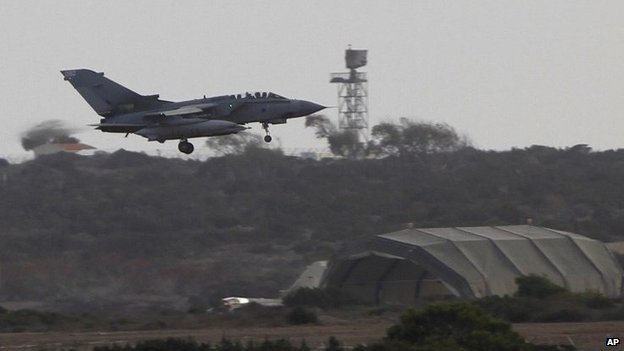
After the parliamentary vote in favour of taking action against Islamic State militants, a phoney war kicked off.
RAF Tornados conducted at least five missions over Iraq, and returned five times
ليس لديك تصريح لمشاهدة الرابط، فضلا قم ب تسجيل الدخول او تسجيل
, before finally
ليس لديك تصريح لمشاهدة الرابط، فضلا قم ب تسجيل الدخول او تسجيل
on Tuesday.Why, after more than a month of British reconnaissance flights, access to allied intelligence, and intense fighting on the ground, did Britain appear to be struggling to find targets?
First, Britain's legally and politically-driven decision to strike only in Iraq, and not Syria, means we cannot strike Islamic State's (IS) main political and economic infrastructure in northern and eastern Syria, nor participate in the much-belated effort to relieve Syrian Kurds in the town of Kobane.
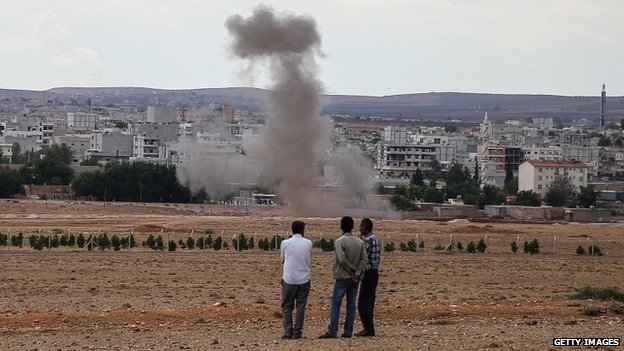
The contrast between intensive US-led bombing across Syria on the one hand and anticlimactic British sorties in Iraq on the other will have been apparent to all.
Second,
ليس لديك تصريح لمشاهدة الرابط، فضلا قم ب تسجيل الدخول او تسجيل
between the two countries. In Syria, the US and its Arab allies struck mostly at fixed sites, such as IS-held military bases, command hubs, oil facilities and gas plants.In Iraq, the US - and more recently, France - has been striking tactical battlefield targets, including massed units of IS fighters and their vehicles, often in close co-ordination with Kurdish ground forces.
ليس لديك تصريح لمشاهدة الرابط، فضلا قم ب تسجيل الدخول او تسجيل
, a garrison, and a training camp in Syria, but only four armoured vehicles and a "fighting position" in Iraq.
ليس لديك تصريح لمشاهدة الرابط، فضلا قم ب تسجيل الدخول او تسجيل
since August have targeted vehicles, overwhelmingly in Iraq. These Iraqi targets are often smaller, easier to conceal and more mobile than their Syrian counterparts - and therefore much harder to identify, track and destroy.In choosing to stick to Iraq, Britain has signed up for an operationally more difficult mission. Moreover, IS has had a long time to prepare for airstrikes and will have spent the past month dispersing and concealing its forces, having learnt lessons from the first wave of US airstrikes that began in August.
Indeed, it is easy to get it wrong even with immobile targets. On Monday morning, the coalition reportedly struck a base that was
ليس لديك تصريح لمشاهدة الرابط، فضلا قم ب تسجيل الدخول او تسجيل
.And so while British aircraft might previously have identified an IS unit or building in a particular location, the coalition will have to find them again.
Third, these targeting challenges mean that airstrikes often require so-called forward air controllers - personnel on the ground who can precisely designate a target for aircraft. Three years ago in Libya, for instance, SAS forces helped guide Nato airstrikes onto Libyan military targets.
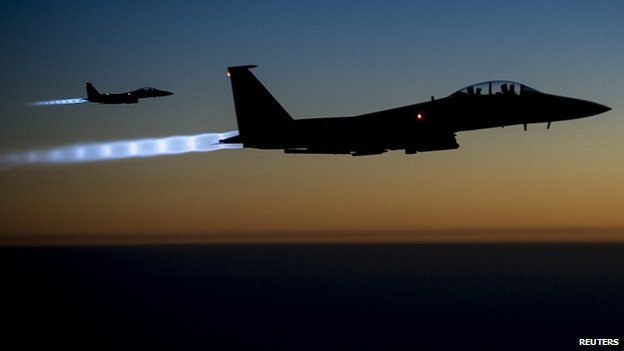
Although British and allied special forces have been present in Iraq for more than a month, it is possible they are only now taking a more aggressive position, deeper inside Iraq, after parliamentary authorisation.
Fourth, the government's sensitivity to civilian casualties is likely to be exceptionally high, both because of domestic political concerns and concern over pushing Iraqi Sunnis further into the arms of IS.
The coalition will be aware that misplaced strikes will risk the Arab military participation in the coalition, help recruitment to IS, and undermine the broader political effort - peeling Sunnis away from IS.
This largely rules out early strikes inside IS-held cities, at least until the intelligence picture develops further and local ground forces are in a better position to take advantage.
It also means Britain will be loath to drop bombs on congested battlefields, where they run the risk of killing allied forces - Kurds or Iraqi soldiers - rather than jihadists.
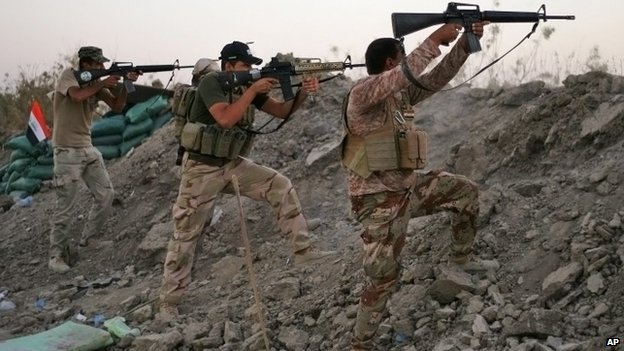
Fifth, Britain's coverage will be relatively limited, given that we have only devoted six Tornado jets to the mission -
ليس لديك تصريح لمشاهدة الرابط، فضلا قم ب تسجيل الدخول او تسجيل
This small contribution is itself a reflection of our
ليس لديك تصريح لمشاهدة الرابط، فضلا قم ب تسجيل الدخول او تسجيل
compared to more than four times this number 25 years ago.Eight Tornados are already deployed in Afghanistan. Even adding in Britain's surveillance aircraft, this pales in comparison with the array of firepower the US has deployed, including drones, cruise missiles and five different types of combat-capable aircraft.
But these targeting challenges speak to a deeper issue: airpower alone, without effective and co-ordinated ground forces, is a very limited instrument, even with months of careful intelligence collection and total control of the skies.
Nearly two months after the US first began airstrikes in Iraq, IS continues to advance.
To give only one example. Within the past two weeks the group has been able to conduct a
ليس لديك تصريح لمشاهدة الرابط، فضلا قم ب تسجيل الدخول او تسجيل
, eventually massacring between 100 and 500 soldiers.Such incidents will recur and it will be hard for Western nations to explain why, after all the political noise, there are no quick military solutions.
But the coalition has accepted this will be a long war, measured in months or years rather than weeks. They therefore see no rush to blow things up - slow and steady, rather than shock and awe.
ليس لديك تصريح لمشاهدة الرابط، فضلا قم ب تسجيل الدخول او تسجيل
is a senior research fellow of the Royal United Services Institute (RUSI) in London.
ليس لديك تصريح لمشاهدة الرابط، فضلا قم ب تسجيل الدخول او تسجيل
اسباب متعددة يشير لها المقال بعنوان ( لماذا مهمة الطائرات البريطانية صعبة في العراق ... ويشير تحديدا للتورنيدو )
فهل نتفق الآن ان المشكلة تواجهها جميع المقاتلات ( كما وعدتنا )
!!
ننتقل للنقطة الثانية ... طاقة المحركات وارتباط ذلك بالرادار ...
مبدئيا لم اجد مايشير للطاقة المتولدة ولكن وجدت عن قوة الدفع بالباوند ..
محرك الاف35 ( الـF-135 ) يولد قوة دفع تقصوى تصل لـ 43,000 باوند

بينما يصل محرك الرافال ( الواحد ) بنسخة ECO لقوة دفع قصوى تبلغ 20,250 ( او مامجموعه 40,500 باوند للمحركين كقوة دفع قصوى )
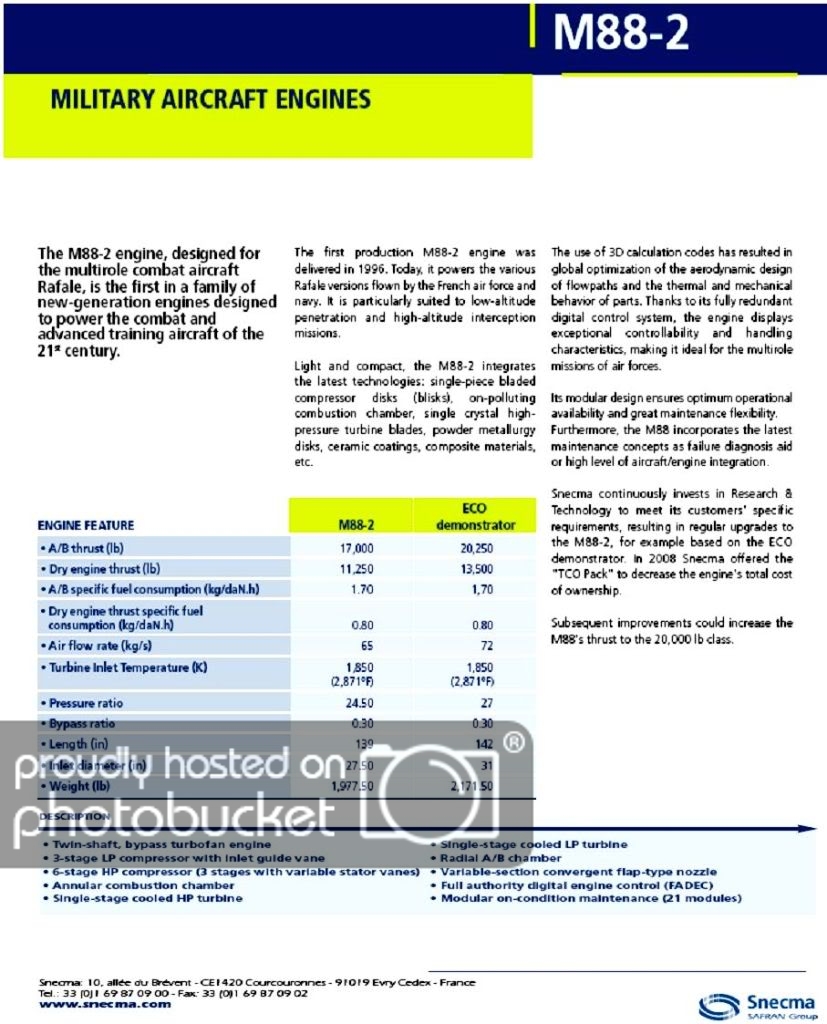
الفرق بينهم 2500 باوند فحسب !!!
*******************
شخصيا لا ارى الفرق كبيرا خاصة لجهة دعم المعدات على متن المقاتلات بالطاقة اللازمة ..
*******************
هذا ان صح فهمي لارتباط قوة الدفع بالطاقة (Kw) ... وعلى كل ,, الفرق ليس كبيرا
مبدئيا لم اجد مايشير للطاقة المتولدة ولكن وجدت عن قوة الدفع بالباوند ..
محرك الاف35 ( الـF-135 ) يولد قوة دفع تقصوى تصل لـ 43,000 باوند

بينما يصل محرك الرافال ( الواحد ) بنسخة ECO لقوة دفع قصوى تبلغ 20,250 ( او مامجموعه 40,500 باوند للمحركين كقوة دفع قصوى )

الفرق بينهم 2500 باوند فحسب !!!
*******************
شخصيا لا ارى الفرق كبيرا خاصة لجهة دعم المعدات على متن المقاتلات بالطاقة اللازمة ..
*******************
هذا ان صح فهمي لارتباط قوة الدفع بالطاقة (Kw) ... وعلى كل ,, الفرق ليس كبيرا
الاف 35 تعاني من مشاكل حقيقية ... لن اقارنها بمقاتلة كالرافال ( لجهة القتال جو-جو , المدى القتالي , الحمولة , وما شابه )
اترك لكم تحليلات بيير سبراي ( احد مصممي الاف 16 )
************
بخصوص خفائية المقاتلة ( لا ادري هل الخبر دعاية مضادة للمقاتلة من روسيا اليوم او بوينج ام لا ) ولكن اترك لكم الخبر
Money for nothing? Boeing says F-35 isn’t so stealth after all
بوينج تقول ( على لسان نائب مدير برامج السوبر هورنت ) ان الاف35 ليست خفية بعد كل هذا ..
But now in addition to the continuously increasing costs, the F-35's actual ability to stealthily soar through the sky is being called into question.
Mike Gibbons is the vice president for Boeing’s Super Hornet and Growler programs, and has good reason to talk down the F-35s—after all, less money to Lockheed Martin likely means more for his firm. Regardless, Gibbons told Osborn and Hoffman that the F-35 is no longer as advanced of a stealth craft as once claimed, and is not as effective as the Growler when it comes to countering a wide spectrum of air defense systems.
تبدو بخصائص خفاء من المقدمة

ولكن بالعرض !!
تبدو اقل في خصائص الخفاء ( خاصة لجهة البدن الممتلئ )

بحاويات داخلية .. تبرز مشكلة الحمولة المحدودة جدا ( وهو ما لن يؤهلها لقصف فاعل بمثل الرافال وغيرها )
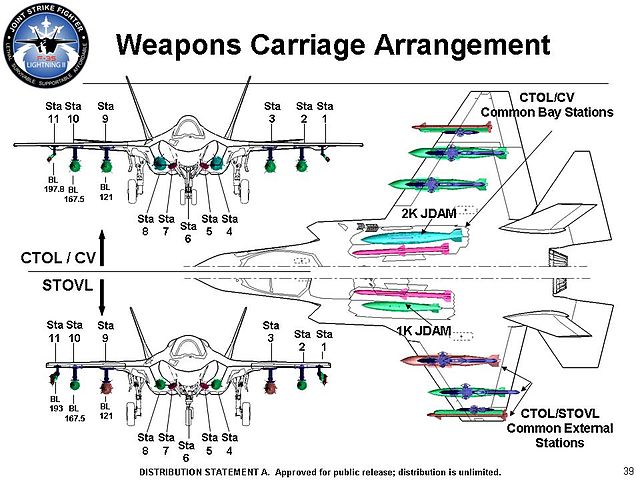

وان تم تحميلها بأسلحة على النقاط الخارجية + خزانات + بودات... ستضعف خصائص الخفاء جدا وهو الامر بنيت لاجله الاف 35 ( مقاتلة شبحية )
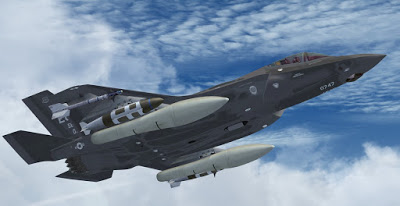

اترك لكم تحليلات بيير سبراي ( احد مصممي الاف 16 )
************
بخصوص خفائية المقاتلة ( لا ادري هل الخبر دعاية مضادة للمقاتلة من روسيا اليوم او بوينج ام لا ) ولكن اترك لكم الخبر
Money for nothing? Boeing says F-35 isn’t so stealth after all
بوينج تقول ( على لسان نائب مدير برامج السوبر هورنت ) ان الاف35 ليست خفية بعد كل هذا ..
But now in addition to the continuously increasing costs, the F-35's actual ability to stealthily soar through the sky is being called into question.
Mike Gibbons is the vice president for Boeing’s Super Hornet and Growler programs, and has good reason to talk down the F-35s—after all, less money to Lockheed Martin likely means more for his firm. Regardless, Gibbons told Osborn and Hoffman that the F-35 is no longer as advanced of a stealth craft as once claimed, and is not as effective as the Growler when it comes to countering a wide spectrum of air defense systems.
ليس لديك تصريح لمشاهدة الرابط، فضلا قم ب تسجيل الدخول او تسجيل
تبدو بخصائص خفاء من المقدمة

ولكن بالعرض !!
تبدو اقل في خصائص الخفاء ( خاصة لجهة البدن الممتلئ )
بحاويات داخلية .. تبرز مشكلة الحمولة المحدودة جدا ( وهو ما لن يؤهلها لقصف فاعل بمثل الرافال وغيرها )

وان تم تحميلها بأسلحة على النقاط الخارجية + خزانات + بودات... ستضعف خصائص الخفاء جدا وهو الامر بنيت لاجله الاف 35 ( مقاتلة شبحية )


الان مشغول وراح أرد ان شاء الله اذا توفر الوقت
وشكرا
ترجع بالسلامه صديقي والله يحفظك
مشكلة المقاتلات البريطانية في تحديد الأهداف وذكر ان الترنيدو عادة بكامل حمولتها اكثر من خمس مراتالمشكلة في فهمك صديقي وليس في المصدر ... المصدر الذي وضعته هو نفسه الذي اتيت به انت ولكن باللغة الانجليزية فحسب لتسهيل الفهم والترجمه
اما بخصوص التورنيدو ... فقد وجدت مقالا بعنوان ( لماذا مهمة الطائرات البريطانية شاقة في العراق ) ... تماما كما وضعت انت المشاركة السابقة
Why UK warplanes have a 'difficult' Iraq mission

After the parliamentary vote in favour of taking action against Islamic State militants, a phoney war kicked off.
RAF Tornados conducted at least five missions over Iraq, and returned five timesليس لديك تصريح لمشاهدة الرابط، فضلا قم ب تسجيل الدخول او تسجيل, before finallyليس لديك تصريح لمشاهدة الرابط، فضلا قم ب تسجيل الدخول او تسجيلon Tuesday.
Why, after more than a month of British reconnaissance flights, access to allied intelligence, and intense fighting on the ground, did Britain appear to be struggling to find targets?
First, Britain's legally and politically-driven decision to strike only in Iraq, and not Syria, means we cannot strike Islamic State's (IS) main political and economic infrastructure in northern and eastern Syria, nor participate in the much-belated effort to relieve Syrian Kurds in the town of Kobane.
IS fighters attacked the border town of Kobane
The contrast between intensive US-led bombing across Syria on the one hand and anticlimactic British sorties in Iraq on the other will have been apparent to all.
Second,ليس لديك تصريح لمشاهدة الرابط، فضلا قم ب تسجيل الدخول او تسجيلbetween the two countries. In Syria, the US and its Arab allies struck mostly at fixed sites, such as IS-held military bases, command hubs, oil facilities and gas plants.
In Iraq, the US - and more recently, France - has been striking tactical battlefield targets, including massed units of IS fighters and their vehicles, often in close co-ordination with Kurdish ground forces.
ليس لديك تصريح لمشاهدة الرابط، فضلا قم ب تسجيل الدخول او تسجيل, a garrison, and a training camp in Syria, but only four armoured vehicles and a "fighting position" in Iraq.
ليس لديك تصريح لمشاهدة الرابط، فضلا قم ب تسجيل الدخول او تسجيلsince August have targeted vehicles, overwhelmingly in Iraq. These Iraqi targets are often smaller, easier to conceal and more mobile than their Syrian counterparts - and therefore much harder to identify, track and destroy.
In choosing to stick to Iraq, Britain has signed up for an operationally more difficult mission. Moreover, IS has had a long time to prepare for airstrikes and will have spent the past month dispersing and concealing its forces, having learnt lessons from the first wave of US airstrikes that began in August.
Indeed, it is easy to get it wrong even with immobile targets. On Monday morning, the coalition reportedly struck a base that wasليس لديك تصريح لمشاهدة الرابط، فضلا قم ب تسجيل الدخول او تسجيل.
And so while British aircraft might previously have identified an IS unit or building in a particular location, the coalition will have to find them again.
Third, these targeting challenges mean that airstrikes often require so-called forward air controllers - personnel on the ground who can precisely designate a target for aircraft. Three years ago in Libya, for instance, SAS forces helped guide Nato airstrikes onto Libyan military targets.
US Air Force Strike Eagles flying over northern Iraq after conducting air strikes in Syria
Although British and allied special forces have been present in Iraq for more than a month, it is possible they are only now taking a more aggressive position, deeper inside Iraq, after parliamentary authorisation.
Fourth, the government's sensitivity to civilian casualties is likely to be exceptionally high, both because of domestic political concerns and concern over pushing Iraqi Sunnis further into the arms of IS.
The coalition will be aware that misplaced strikes will risk the Arab military participation in the coalition, help recruitment to IS, and undermine the broader political effort - peeling Sunnis away from IS.
This largely rules out early strikes inside IS-held cities, at least until the intelligence picture develops further and local ground forces are in a better position to take advantage.
It also means Britain will be loath to drop bombs on congested battlefields, where they run the risk of killing allied forces - Kurds or Iraqi soldiers - rather than jihadists.
Iraqi Shia militiamen are trying to stop IS from reaching Baghdad
Fifth, Britain's coverage will be relatively limited, given that we have only devoted six Tornado jets to the mission -ليس لديك تصريح لمشاهدة الرابط، فضلا قم ب تسجيل الدخول او تسجيل
This small contribution is itself a reflection of ourليس لديك تصريح لمشاهدة الرابط، فضلا قم ب تسجيل الدخول او تسجيلcompared to more than four times this number 25 years ago.
Eight Tornados are already deployed in Afghanistan. Even adding in Britain's surveillance aircraft, this pales in comparison with the array of firepower the US has deployed, including drones, cruise missiles and five different types of combat-capable aircraft.
But these targeting challenges speak to a deeper issue: airpower alone, without effective and co-ordinated ground forces, is a very limited instrument, even with months of careful intelligence collection and total control of the skies.
Nearly two months after the US first began airstrikes in Iraq, IS continues to advance.
To give only one example. Within the past two weeks the group has been able to conduct aليس لديك تصريح لمشاهدة الرابط، فضلا قم ب تسجيل الدخول او تسجيل, eventually massacring between 100 and 500 soldiers.
Such incidents will recur and it will be hard for Western nations to explain why, after all the political noise, there are no quick military solutions.
But the coalition has accepted this will be a long war, measured in months or years rather than weeks. They therefore see no rush to blow things up - slow and steady, rather than shock and awe.
ليس لديك تصريح لمشاهدة الرابط، فضلا قم ب تسجيل الدخول او تسجيلis a senior research fellow of the Royal United Services Institute (RUSI) in London.
ليس لديك تصريح لمشاهدة الرابط، فضلا قم ب تسجيل الدخول او تسجيل
اسباب متعددة يشير لها المقال بعنوان ( لماذا مهمة الطائرات البريطانية صعبة في العراق ... ويشير تحديدا للتورنيدو )
فهل نتفق الآن ان المشكلة تواجهها جميع المقاتلات ( كما وعدتنا )
!!
مشكلة المقاتلات البريطانية في تحديد الأهداف وذكر ان الترنيدو عادة بكامل حمولتها اكثر من خمس مرات
ونفس المشكلة ذكرت في قصة الرافال ...
اسألك سؤالا صريحا : هل تتفق معي الآن ان المشكلة على الجميع ( كما وعدتني )
!!
هذا لا يعني التقليل من قدرات الايقل حتى لوشاركت من الخليج ... ومتى مانشاهد صور لها من القواعد الجوية مثل F-22 والرافال من قاعدة الظفرة نبني عليها وقتها في المدى لكل مقاتلة ولا نأخذ بالمصادر المتضاربة ..بل ثبتت مشاركتها من الشرق الاوسط ( ومن شبه الجزيرة العربية تحديدا ) ... الاف 15 اس السعودية
Airstrikes against Islamic State terrorists in Iraq and Syria this week featured the combat debut of the Lockheed Martin F-22 Raptor stealth fighter, and of the Royal Saudi Air Force F-15S Strike Eagle. The air forces of Bahrain, France, Jordan, Qatar and the UAE also participated, and the Royal Australian Air Force is en route to the fight with F-18s and a Wedgetail AEW aircraft. The U.S.ليس لديك تصريح لمشاهدة الرابط، فضلا قم ب تسجيل الدخول او تسجيل, and the effort to stem the advance of Islamic State and other terrorist groups from the air has increased steadily since then.
ليس لديك تصريح لمشاهدة الرابط، فضلا قم ب تسجيل الدخول او تسجيل
واخرى انطلقت من قاعدة سالم الصباح بالكويت اضافة للضفرة
B1s bombing ISIS from al Udeid Air Base in Qatar, F-15/16s from Ali al Salem Base in Kuwait & al Dhafra Base in UAEليس لديك تصريح لمشاهدة الرابط، فضلا قم ب تسجيل الدخول او تسجيل

وإذاكان الانطلاق من الكويت نعم يوجد فرق كبير في المدى عن الإمارات ...
ونفس المشكلة ذكرت في قصة الرافال ...
اسألك سؤالا صريحا : هل تتفق معي الآن ان المشكلة على الجميع ( كما وعدتني )
!!
فرق بين كبير بين مشكلة الرافال في نقل المقاتلات الي قرب مسرح العمليات والترنيدو في صعوبة في تحديد الأهداف
فرق بين كبير بين مشكلة الرافال في نقل المقاتلات الي قرب مسرح العمليات والترنيدو في صعوبة في تحديد الأهداف
لن استطيع افهامك برغم كل المصادر التي اتيت بها ...
شكرا جزيلا على الحوار على كل حال
هذا لا يعني التقليل من قدرات الايقل حتى لوشاركت من الخليج ... ومتى مانشاهد صور لها من القواعد الجوية مثل F-22 والرافال من قاعدة الظفرة نبني عليها وقتها في المدى لكل مقاتلة ولا نأخذ بالمصادر المتضاربة ..
وإذاكان الانطلاق من الكويت نعم يوجد فرق كبير في المدى عن الإمارات ...
جميل .. وماذا عن الاف 15 السعودية التي شاركت بالقصف !!
Airstrikes against Islamic State terrorists in Iraq and Syria this week featured the combat debut of the Lockheed Martin F-22 Raptor stealth fighter, and of the Royal Saudi Air Force F-15S Strike Eagle. The air forces of Bahrain, France, Jordan, Qatar and the UAE also participated, and the Royal Australian Air Force is en route to the fight with F-18s and a Wedgetail AEWaircraft. The U.S.
ليس لديك تصريح لمشاهدة الرابط، فضلا قم ب تسجيل الدخول او تسجيل
, and the effort to stem the advance of Islamic State and other terrorist groups from the air has increased steadily since then.الاف 22 شاركت من الضفرة
ليس لديك تصريح لمشاهدة الرابط، فضلا قم ب تسجيل الدخول او تسجيل
A U.S. Air Force F-22 Raptor stealth fighter departs Al Dhafra airbase in the UAE for the type’s first combat mission, over Syria. (Photos: US DoD).
ليس لديك تصريح لمشاهدة الرابط، فضلا قم ب تسجيل الدخول او تسجيل
الاف 15 السعودية هل اتت من اوروبا ام من شبه الجزيرة العربية !!
هنا مصدر يشير الى ان بعض الاف 15 التي شاركت تنتمي للسرب 48FW والذي يتمركز حاليا في قاعدة العديد في قطر 
The presence of
According to our sources, some F-15Es belonging to 48FW from RAF Lakenheath are currently deployed to Al Udeid, in Qatar.
هذه شارات السرب

Current version of the 48th Fighter Wing at RAF Lakenheath, the Statue of Liberty Wing. Only wing in the USAF to have two official designations. Flies F-15E's and C's.

Desert version of the 48th Fighter Wing at RAF Lakenheath, the Statue of Liberty Wing.
لا استطيع الافتاء من عندي كونه لا تتوفر معلومات كافية حول اماكن تمركز الطائرات .. لكن هذا ماوجدته ..
قد تكون عملية انتشار للاف 15 للعديد للتحضير للعمليات القتالية ...
The presence of
ليس لديك تصريح لمشاهدة الرابط، فضلا قم ب تسجيل الدخول او تسجيل
confirmed since the beginning of the air campaign against ISIS, is far from being surprising. What makes the video worth of note is the fact that it is the first one to show the Strike Eagles from the ground, as they fly over Iraq.According to our sources, some F-15Es belonging to 48FW from RAF Lakenheath are currently deployed to Al Udeid, in Qatar.
ليس لديك تصريح لمشاهدة الرابط، فضلا قم ب تسجيل الدخول او تسجيل
هذه شارات السرب
Current version of the 48th Fighter Wing at RAF Lakenheath, the Statue of Liberty Wing. Only wing in the USAF to have two official designations. Flies F-15E's and C's.

Desert version of the 48th Fighter Wing at RAF Lakenheath, the Statue of Liberty Wing.
لا استطيع الافتاء من عندي كونه لا تتوفر معلومات كافية حول اماكن تمركز الطائرات .. لكن هذا ماوجدته ..
قد تكون عملية انتشار للاف 15 للعديد للتحضير للعمليات القتالية ...
غموض وغموض ...
نفس الوضع مع الاف 15 التي ضربتها داعش بمضادات الطائرات واجبرتها على الهبوط في تركيا ..
ISIL hit U.S. F-15 with anti-aircaft batteries captured from Iraq
من اين اتت ؟؟!!
****************
هناك مصادر تشير لكونها طارت من العديد ( كما اشرت في المشاركة السابقة ) وقامت بعمليات تزود بالوقود جوا
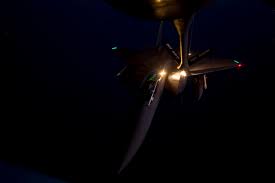
انا شخصيا لا استبعد ذلك ... الـB1 Lancer برغم كونها قاذفة استراتيجية لها مدى اقصى يبلغ 12,000 كم

والاف 22 كذلك برغم افضلية السوبر كروز والاداء الايروديناميكي الافضل ..

نفس الوضع مع الاف 15 التي ضربتها داعش بمضادات الطائرات واجبرتها على الهبوط في تركيا ..
ISIL hit U.S. F-15 with anti-aircaft batteries captured from Iraq
من اين اتت ؟؟!!
****************
هناك مصادر تشير لكونها طارت من العديد ( كما اشرت في المشاركة السابقة ) وقامت بعمليات تزود بالوقود جوا
انا شخصيا لا استبعد ذلك ... الـB1 Lancer برغم كونها قاذفة استراتيجية لها مدى اقصى يبلغ 12,000 كم

ليس لديك تصريح لمشاهدة الرابط، فضلا قم ب تسجيل الدخول او تسجيل
والاف 22 كذلك برغم افضلية السوبر كروز والاداء الايروديناميكي الافضل ..

من الصعب التكهن بمواقع انتشار مجموعات القتال ... من كان يضن ان التايفون البريطانية - ضمن مجموعة القتال - تتخذ من العديد مقرا لها ( كمثال )
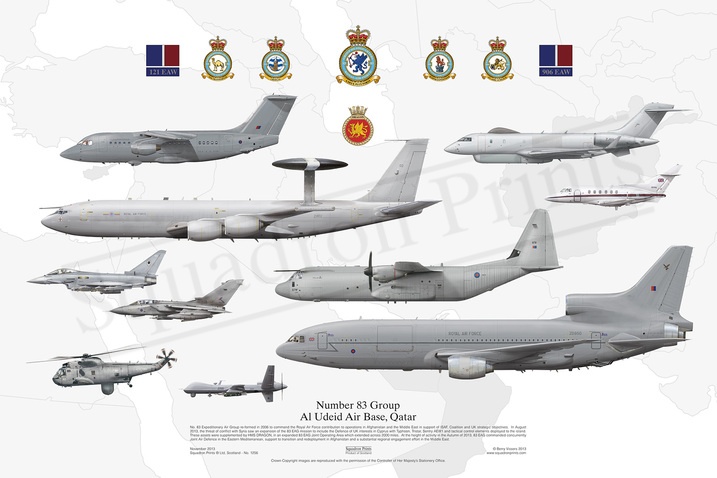
وهنا الاف 15 E في قاعدة الضفرة الاماراتية

F-15 fighters based at Al Dhafra Air Base. Since the UAE does not possess F-15s and judging from the paint job, they are likely to be USAF F-15Es. This image dates back to late June, but is comparatively a much larger deployment than previous years combined: one lone pairs of F-15s were seen on the tarmac previous to this image.
ولكي نضع النقاط على الحروف ... يقول مدير العمليات في الاركان المشتركة بالبنتاغون :
( من بين المقاتلات التي قامت بهجمات , الاف 15 اي سترايك ايجل والاف 16 الصقر المقاتل ,, والتي تنتشر اسرابها بصورة دورية في قاعدة العديد )
Occasionally, military commanders provide hard clues about where U.S. warplanes are flying from. On Aug. 11, Lt. Gen. William C. Mayville Jr., director of operations for the Pentagon’s Joint Staff, told reporters that among the planes carrying out airstrikes were F-15E Strike Eagles and F-16 Fighting Falcons. Squadrons of both fighter jets are routinely deployed to al Udeid.
On Aug. 17, Central Command announced that U.S. bomber aircraft had joined the air campaign. Although it did not give details, officials acknowledged that the statement referred to B-1 bombers, which are also based at al Udeid.
اذا ... الاف 15 ( بحسب كلام المدير ) تتواجد اسرابها في قاعدة العديد الجوية في قطر ..

وهنا الاف 15 E في قاعدة الضفرة الاماراتية

F-15 fighters based at Al Dhafra Air Base. Since the UAE does not possess F-15s and judging from the paint job, they are likely to be USAF F-15Es. This image dates back to late June, but is comparatively a much larger deployment than previous years combined: one lone pairs of F-15s were seen on the tarmac previous to this image.
ليس لديك تصريح لمشاهدة الرابط، فضلا قم ب تسجيل الدخول او تسجيل
ولكي نضع النقاط على الحروف ... يقول مدير العمليات في الاركان المشتركة بالبنتاغون :
( من بين المقاتلات التي قامت بهجمات , الاف 15 اي سترايك ايجل والاف 16 الصقر المقاتل ,, والتي تنتشر اسرابها بصورة دورية في قاعدة العديد )
Occasionally, military commanders provide hard clues about where U.S. warplanes are flying from. On Aug. 11, Lt. Gen. William C. Mayville Jr., director of operations for the Pentagon’s Joint Staff, told reporters that among the planes carrying out airstrikes were F-15E Strike Eagles and F-16 Fighting Falcons. Squadrons of both fighter jets are routinely deployed to al Udeid.
On Aug. 17, Central Command announced that U.S. bomber aircraft had joined the air campaign. Although it did not give details, officials acknowledged that the statement referred to B-1 bombers, which are also based at al Udeid.
ليس لديك تصريح لمشاهدة الرابط، فضلا قم ب تسجيل الدخول او تسجيل
اذا ... الاف 15 ( بحسب كلام المدير ) تتواجد اسرابها في قاعدة العديد الجوية في قطر ..
feel reluctant with u around .. Dr.Mylo
just to hear ur satisfaction is an achievement by itself
That's way more than I deserve, thanks for the compliments
المواضيع المشابهة
- الردود
- 3
- المشاهدات
- 2K
- الردود
- 1
- المشاهدات
- 540
- الردود
- 4
- المشاهدات
- 708
- الردود
- 41
- المشاهدات
- 3K

